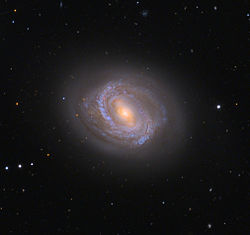Messier 58
| Galaxie Messier 58 | |
|---|---|
 | |
| Die Galaxie Messier 58 aufgenommen mit dem 81-cm-Spiegelteleskop des Mount-Lemmon-Observatoriums. | |
| AladinLite | |
| Sternbild | Jungfrau |
| Position Äquinoktium: J2000.0, Epoche: J2000.0 | |
| Rektaszension | 12h 37m 43,5s[1] |
| Deklination | +11° 49′ 05″[1] |
| Erscheinungsbild | |
| Morphologischer Typ | SAB(rs)b; LINER Sy1.9[1] |
| Helligkeit (visuell) | 9,6 mag[2] |
| Helligkeit (B-Band) | 10,4 mag[2] |
| Winkelausdehnung | 6′ × 4,8′[2] |
| Positionswinkel | 95°[2] |
| Flächenhelligkeit | 13,1 mag/arcmin²[2] |
| Physikalische Daten | |
| Zugehörigkeit | Virgo-Galaxienhaufen |
| Rotverschiebung | 0,005060 ± 0,000002[1] |
| Radialgeschwindigkeit | (1517 ± 1) km/s[1] |
| Hubbledistanz H0 = 73 km/(s • Mpc) | (66 ± 5) · 106 Lj (20,1 ± 1,4) Mpc [1] |
| Durchmesser | 110.000 Lj |
| Geschichte | |
| Entdeckung | Charles Messier |
| Entdeckungsdatum | 15. April 1779[3] |
| Katalogbezeichnungen | |
| M 58 • NGC 4579 • UGC 7796 • PGC 42168 • CGCG 70-197 • MCG +2-32-160 • IRAS 12351+1205 • 2MASX J12374359+1149051 • VCC 1727 • GC 3121 • h 1368 • | |
Messier 58 (auch als NGC 4579 bezeichnet) ist eine 9,6 mag helle Balken-Spiralgalaxie mit einer Flächenausdehnung von 6,0′ × 4,8′ im Sternbild Jungfrau auf der Ekliptik. Die meisten Quellen gehen davon aus, dass es sich bei M58 um eine Balken-Spiralgalaxie vom Typ SBb in der Hubble-Sequenz handelt. Messier 58 wurde am 15. April 1779 vom französischen Astronomen Charles Messier entdeckt.
- Detailaufnahme im sichtbaren Licht des Hubble-Weltraumteleskops
Siehe auch
Literatur
- König, Michael & Binnewies, Stefan (2019): Bildatlas der Galaxien: Die Astrophysik hinter den Astrofotografien, Stuttgart: Kosmos, S. 155
Weblinks
Einzelnachweise
- ↑ a b c d NASA/IPAC EXTRAGALACTIC DATABASE
- ↑ a b c d e SEDS: NGC 4579
- ↑ Courtney Seligman: NGC 4579 (= M58 = PGC 42168). In: Celestial Atlas – NGC Objects: NGC 4550–4599. 16. August 2023. Auf CSeligman.com, abgerufen am 9. Dezember 2023 (englisch).
Auf dieser Seite verwendete Medien
Autor/Urheber:
diverse
, Lizenz: CC-by 3.0Bildtafel der 110 Messier-Objekte.
Galaxy NGC 4579 was captured by the Spitzer Infrared Nearby Galaxy Survey (SINGS) Legacy Project using the Spitzer Space Telescope's Infrared Array Camera (IRAC). In this image, the red structures are areas where gas and dust are thought to be forming new stars, while the blue light comes from mature stars. This SINGS image is a four-channel, false-color composite, where blue indicates emission at 3.6 microns, green corresponds to 4.5 microns, and red to 5.8 and 8.0 microns. The contribution from starlight (measured at 3.6 microns) in this picture has been subtracted from the 5.8 and 8 micron images to enhance the visibility of the dust features.
Autor/Urheber: Credit Line and Copyright Adam Block/Mount Lemmon SkyCenter/University of Arizona, Lizenz: CC BY-SA 3.0 us
Picture Details:
Optics 32-inch Schulman Telescope (RC Optical Systems), Acquired remotely Camera SBIG STX 16803 CCD Camera Filters AstroDon Gen II Dates January 2012 Location Mount Lemmon SkyCenter Exposure LRGB = 240:70:70:70 minutes Acquisition ACP Observatory Control Software (DC-3 Dreams),TheSky (Software Bisque), Maxim DL/CCD (Cyanogen) Processing CCDStack (CCDWare), Photoshop CS5 (Adobe), PixInsightCredit Line and Copyright Adam Block/Mount Lemmon SkyCenter/University of Arizona
Autor/Urheber: Own work, Lizenz: CC BY-SA 3.0
Color rendering is done by by Aladin-software (2000A&AS..143...33B.)






